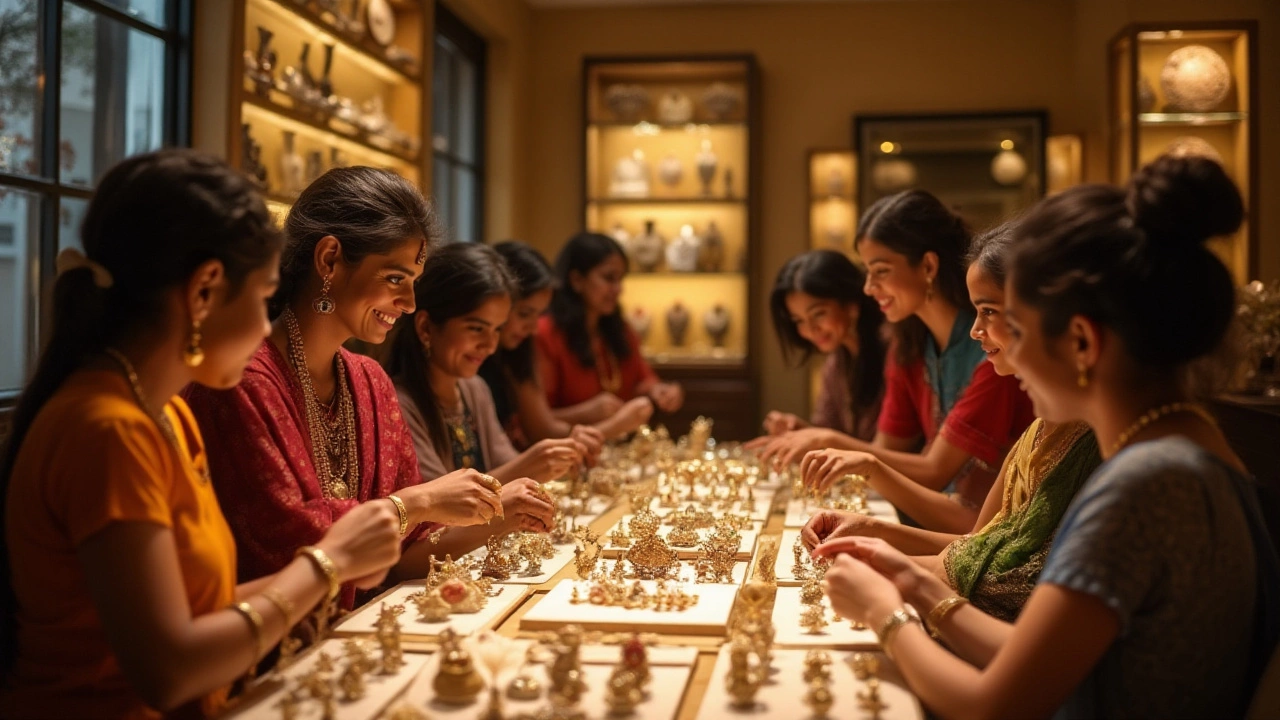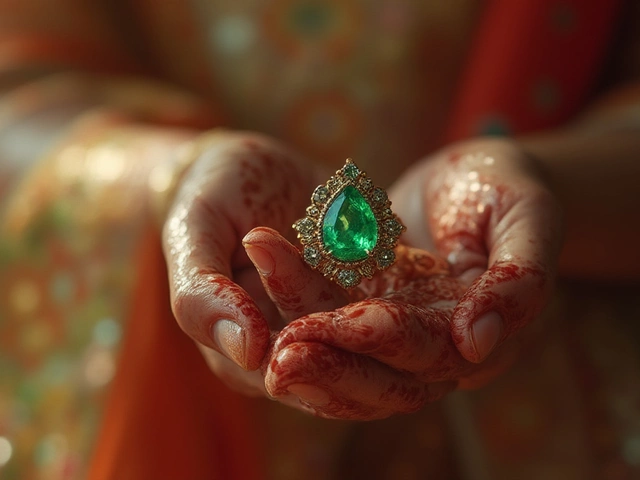
The art of jewelry making continues to enchant countless creative souls, inspiring a myriad of burgeoning businesses and hobbyists alike. Many find themselves drawn into this vibrant industry, but a frequent question that emerges is: Is the jewelry business today too saturated for new entrants to thrive?
This piece delves into the crux of the jewelry market. By examining the elements that have contributed to the current business landscape, including the ever-popular jewelry making kits, we seek to understand the dynamics at play.
It will be crucial to explore what truly lies ahead for those with ambitions to carve out their niche. Let us embark on a journey that not only brings clarity to the state of the industry but also empowers aspiring jewelers with insights on navigating this alluring yet competitive space.
- Introduction to the Jewelry Market
- Understanding Market Saturation
- The Rise of Jewelry Making Kits
- Trends Shaping the Jewelry Industry
- Challenges New Entrants Face
- Tips for Succeeding in a Crowded Market
Introduction to the Jewelry Market
The jewelry market is a fascinating blend of tradition and innovation, a tapestry woven with golden threads of history and sparkling gems of contemporary creativity. Stepping back in time, we observe an industry deeply rooted in antiquity, where ancient civilizations adorned themselves with meticulously crafted ornaments made from bones, shells, and metallic elements. Fast forward to today, the market boasts a diverse plethora of styles ranging from mass-produced items to exclusive, handcrafted pieces recognized universally. Jewelers today capitalize on evolving consumer preferences and technological advances, bringing to life unique designs that cater to a variety of tastes and price points.
In recent years, the jewelry sector has experienced an influx of new entrants, particularly small businesses and hobbyists eager to share their creative expressions through DIY jewelry making. The rise of jewelry making kits has democratized the industry and provided a burgeoning infrastructure for aspiring artisans to access the tools and materials they need to succeed. This interesting shift has made the jewelry business simultaneously more accessible and competitive.
On the global stage, the industry shows promising resilience and growth potential. According to data from Statista, the global jewelry market accumulated a revenue of about $280 billion in 2023, with projections showing a consistent increase. Such figures underscore the industry's robust nature, cementing jewelry's role as more than mere adornment but a staple in modern fashion.
Market Dynamics
Beneath the shimmering surface of jewels lies a complex web of market dynamics that defines success for stakeholders. Factors such as consumer purchasing power, preferences driven by cultural shifts, and the sustainability movement shape this landscape. With these in mind, businesses strategize to cater to ethically conscious consumers demanding transparency and traceability. As a result, the ethical segment of this market has become a strong contender worth $8 billion in 2023 according to McKinsey. This creates pivotal opportunities for new participants to not only consider pricing and design but also align with modern ethical values.
Given these dynamics, the jewelry industry today adapts to the ever-evolving digital era which brings forth innovative avenues for marketing and distribution. With social media playing an integral role, jewelers exhibit and sell their creations online, reaching broader audiences than ever imagined. Such platforms provide insights into customer behaviors, adding an extra layer of personalization in customer engagements. It is no wonder then that more than half of jewelry sales involve some digital means, illustrating the need for jewelers to maintain an online presence.
"Jewelry is not just ornamentation; it is a statement, a status symbol, and an emotional connection," says renowned industry analyst Simone Levinsky.
This intricate interplay of factors makes the jewelry making kits not only directly impactful but also a reflection of a broader set of market influences. They encourage exploration into uncharted territories of creative potential, whether the artisan is a veteran jeweler or a curious beginner. Ultimately, the market continues to attract both creators and consumers with its enigmatic charm, unraveling new possibilities one gemstone at a time.
Understanding Market Saturation
To truly grasp the concept of market saturation in the jewelry business, one must first familiarize themselves with the core idea. Market saturation occurs when a product or service is so widespread that the growth potential becomes limited. In the realm of jewelry, this means an abundance of sellers are offering similar designs and products, leading to increased competition and limited space for new players. The surge in popularity of jewelry making kits has enabled countless aspiring designers to enter the market, adding to this phenomenon. An essential factor is whether these new entrants can bring a fresh perspective to classic designs.
The accessibility of creating DIY jewelry has exploded with technology making it easier to reach potential consumers. Platforms like Etsy and Instagram have leveled the playing field, providing artisans the means to showcase their creations globally. However, with a vast sea of creators, distinguishing oneself becomes more challenging. The depth of the industry's saturation can be analyzed through metrics such as the growth rate of new jewelry businesses compared to consumer demand. Identifying niches, crafting unique brand stories, and innovation in design are strategic ways to bypass the hurdles posed by saturation.
Despite these challenges, numerous brands have successfully navigated this complex terrain. A study by the Jewelers of America points out that businesses focusing on customized experiences rather than mass production tend to appeal more to today’s discerning customers. Emphasizing quality over quantity not only helps build a loyal client base but also supports sustainable practices, which are increasingly important to consumers.
"In an industry inundated with options, authenticity, and distinctiveness become your most valuable assets," says Sarah Graham, a renowned jewelry designer.
Moreover, market saturation is not just about sheer numbers. It is also about the perception of sameness in what is being offered. Often, a lack of variety in style, quality, or pricing can amplify the issues surrounding saturation. Therefore, understanding these nuances is key to identifying if there truly is an oversaturation or merely a lack of market differentiators. Engaging with consumer feedback and analyzing competitors can offer valuable insights to craft a path forward that ensures resilience and success in this competitive field.

The Rise of Jewelry Making Kits
In recent years, jewelry making kits have emerged as a significant trend, catching the attention of those eager to dive into the world of jewelry creation without the steep learning curve. These kits offer an accessible entry point into an industry that once seemed reserved for skilled artisans and designers. They include everything a beginner might need to get started, from tools to materials, packaged neatly for convenience. This democratization of jewelry making is largely due to the DIY movement, which emphasizes creativity, personal expression, and handmade crafts that break away from mass-produced items. This approach resonates deeply with consumers looking for unique, personalized pieces.
The allure of these kits can be traced back to their ability to offer both a creative outlet and a potential income stream. Many aspiring entrepreneurs see these kits as a low-risk way to test the waters of the jewelry business. They provide an opportunity for learning new skills, experimenting with designs, and creating products without having to make a significant investment in professional-grade tools or supplies. Companies supplying these kits often pair product offerings with educational content, offering online courses or tutorials that guide budding jewelry makers through their first projects.
A survey by Arts and Crafts Association revealed that around 55% of respondents had purchased at least one jewelry making kit in the past year, highlighting their growing popularity.
The emergence of kits has revolutionized the entry point into jewelry creation, making the craft more accessible to a wider audience than ever before," noted Jane Smith, author of "The DIY Revolution". "In doing so, it's opened up a world of possibilities for aspiring creators."This insight underscores a significant shift in the market dynamics, encouraging novice artisans who might not have considered entering the jewelry business to give it a try.
Furthermore, the popularity of these kits aligns with shifts in consumer attitudes toward sustainability and the appreciation of handcrafted items. Many consumers are increasingly drawn to products that bear a personal touch or convey a story. Hence, makers leveraging these kits can capitalize on larger social trends favoring artisanal goods. It's noticeable that online marketplaces like Etsy have seen a surge in custom-made and DIY jewelry offerings, indicating the market's readiness for more creative entrepreneurs inspired by their kit-based beginnings.
While the market grows, the challenge comes in standing out within this expanding niche. Although these kits provide the tools, success often hinges on creativity, innovation, and marketing prowess. Sellers are wise to explore unique angles, such as incorporating unusual materials, crafting distinctive designs, or sharing the story behind each piece to add value beyond the basic product. There's a compelling opportunity for creators to carve out a niche by staying attuned to trends and consumer preferences while continually honing their skills and expanding their portfolio.
Trends Shaping the Jewelry Industry
The jewelry business is in constant motion, and staying attuned to emerging trends is essential for anyone hoping to succeed in this space. In recent years, several significant shifts have come to light, profoundly shaping the way consumers engage with jewelry. A notable trend is the increased consumer demand for personalized and bespoke pieces, driven largely by the unique stories each piece can convey. Individuals seek jewelry that reflects their personal journeys and values, often pushing jewelers to prioritize customization and innovative designs that resonate on a deeply personal level. This move towards personalization aligns with broader consumer preferences for products that feel tailored and unique.
For those with an environmentally-conscious mindset, sustainability has become non-negotiable. With growing awareness around ethical sourcing and environmental impact, consumers are more likely to invest in jewelry from brands demonstrating genuine commitment to sustainable practices. Recycled metals and ethically sourced stones are increasingly preferred, and businesses that emphasize transparency in their supply chains often gain a competitive edge. An interesting consumer insight reveals that over 65% of millennials prefer brands that are socially responsible, which signals an enduring shift in purchasing behavior among younger consumers.
Alongside these values-focused trends, technology is reshaping the heart of the jewelry making process itself. 3D printing technology, for instance, has made significant inroads in recent years. This technological innovation allows jewelers to create complex designs with precision and efficiency previously unattainable, opening avenues for creativity and innovation. This has not only reduced production costs but has also made it easier for new entrants to test and prototype their ideas swiftly. As technology continues to evolve, its integration into jewelry making is likely to deepen, bridging traditional craftsmanship with modern capabilities.
"In the emerging landscape, a brand's story and ethical positioning are just as important as the aesthetics of its jewelry," notes Jane A. Smith, Editor-in-Chief of Trends in Fashion Magazine.
On the flip side of high-tech developments, the allure of handmade, artisanal jewelry hasn’t dimmed. There is a resurgence in appreciation for intricate, handcrafted pieces that embody time-honored techniques passed down through generations. This trend, interestingly, complements the tech-driven turn by offering a balance — consumers often purchase 3D-printed pieces along with handcrafted ones to have personalized collections that speak to both modern and traditional worlds.
Social media and digital platforms also play an expansive role in shaping consumer interactions with jewelry brands. Through captivating visuals and direct engagement, platforms like Instagram and Pinterest serve as virtual showrooms where jewelry trends can quickly gain or wane in popularity. Influencer collaborations and digital strategizing are now integral to a brand's jewelry marketing approach.
The fusion of personalization, sustainability, technology adoption, and digital marketing form the backbone of current trends shaping the jewelry industry. Understanding these dynamics and integrating them thoughtfully offers exciting opportunities for those willing to innovate and adapt to the ever-changing desires of jewelry enthusiasts around the world.

Challenges New Entrants Face
Navigating the jewelry business can sometimes feel like discovering a treasure map with cryptic markings—promising and daunting at once. New entrants in the world of jewelry making often find themselves contending with a myriad of challenges that test their creativity, patience, and resolve. One of the primary hurdles is the fierce competition. With the accessibility of online platforms, many fledgling jewelers can start selling their creations quickly, but this ease of entry means the marketplace is bustling with countless talent and styles vying for attention. Distinguishing oneself amid a sea of artisans demands a keen eye for niche markets and a distinctive artistic voice that resonates with consumers.
Another significant challenge lies in sourcing quality materials at a reasonable cost. Aspiring jewelers must strike a delicate balance between maintaining the integrity of their work and managing expenses. Quality materials play a massive role in reputation; a higher price tag may deter some customers, but sacrificing quality risks unfavorable reviews and diminished consumer trust. This issue is compounded by global supply chain disruptions and fluctuating raw material prices. Understanding market trends and economic factors affecting supply chains becomes paramount for new entrants aiming to maintain a foothold in the industry without compromising their product or pricing strategies.
Moreover, the art of jewelry making is not only about crafting exquisite pieces but also mastering the business acumen needed to thrive. Beginners often grapple with marketing their products effectively, managing finances, keeping up with legal requirements, and building a reliable customer base. Marketing in the digital age necessitates a strong online presence, and while social media provides vast opportunities for reaching potential customers, it also requires time and expertise to leverage correctly. Creating engaging content, engaging with audiences, and utilizing tools like SEO can feel like foreign territory to those focused purely on the craft. As Shiana Mangatal, a successful small business owner, once remarked, "The artistry in jewelry making is only part of the journey; learning to market and manage a business is where most of your growth will come from."
Apart from these hurdles, staying relevant is another perpetual challenge. Trends in the jewelry industry evolve rapidly. A design that captivates today might lose its magic tomorrow. Newcomers must stay informed on current styles and preferences, a task easier said than done amidst the whirlwind of fashion seasons and consumer demands. Leveraging customer feedback, staying connected with industry networks, and continually adapting their offerings are vital components to ensuring their brand remains top of mind. Some companies thrive by integrating emerging technologies such as 3D printing or even delving into sustainable practices, which reflect changing consumer values towards eco-friendly products.
Finally, establishing credibility in the jewelry business is a formidable task. Newcomers need to convey authenticity and trustworthiness without boasting extensive portfolios or decades-long legacies. Building a brand from scratch means demonstrating a commitment to quality, ethics, and customer satisfaction from the first interaction. Many successful jewelers have invested in storytelling and personalizing the buying experience to convince prospective buyers that their jewelry not only adorns but also tells a story. With strategic approaches to these challenges, new players can indeed turn these daunting obstacles into stepping stones toward success in the vibrant world of handmade jewelry.
Tips for Succeeding in a Crowded Market
Breaking into the jewelry business might seem daunting with so many players already in the field. However, with strategic approaches, creativity, and a clear understanding of the market, new entrants can find their niche. First, it's essential to thoroughly research the current market trends before delving into your unique offerings. Identifying gaps in the market can lead to significant opportunities. You're not just selling jewelry; you're selling a story, an emotion, a piece of art. Therefore, ensuring your products tell a resonant story can set you apart from others in the industry.
Utilizing jewelry making kits, aspiring designers can experiment with different styles and materials, developing skills and understanding how to craft pieces that speak to modern tastes. One effective strategy is to keep up with consumer preferences, which have shown a shift towards sustainable and personalized jewelry. As consumers become more environmentally conscious, incorporating sustainable practices and materials can not only appeal to a broader audience but also evoke positive brand values.
"Success is not the result of spontaneous combustion. You must set yourself on fire." - Arnold H. Glasow
Building a reliable supply chain is another crucial factor. Reliable suppliers who can provide quality materials on time can significantly influence your production and delivery schedules. Creating lasting partnerships with trustworthy suppliers can help mitigate issues with stock availability and material costs. It's also wise to keep an eye on innovations within the industry. New technologies such as 3D printing and augmented reality are proving transformative by changing traditional manufacturing techniques and enhancing customer interaction, respectively.
Marketing effectively in this crowded marketplace requires an innovative approach. In the digital age, a strong online presence is non-negotiable. Leveraging platforms like Instagram or Pinterest, where visual content thrives, can help you connect with potential customers and showcase your unique designs. Consistency in posting and engaging with your audience can bolster your brand's visibility. Consider incorporating storytelling elements into your campaigns, as genuine and engaging narratives can captivate a wider audience. Building a community around your brand fosters loyalty and can drive word-of-mouth referrals, which are invaluable.
Lastly, continual learning is vital. The jewelry industry is dynamic, with trends that shift like the tides. Investing in workshops or online courses can help hone your craft and stay abreast of new techniques and styles. Networking—both online and offline—with other jewelers can provide insights and opportunities for collaboration or expansion. It's about understanding the intricacies of the market, combined with delivering standout quality and service, that can pave the way for success in the DIY jewelry sector.


